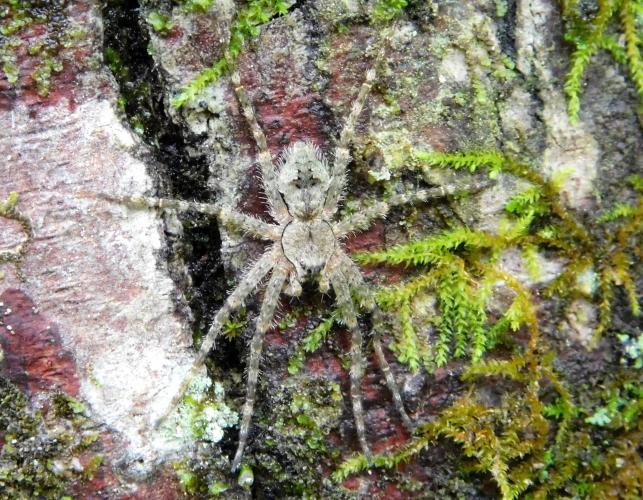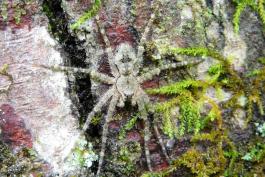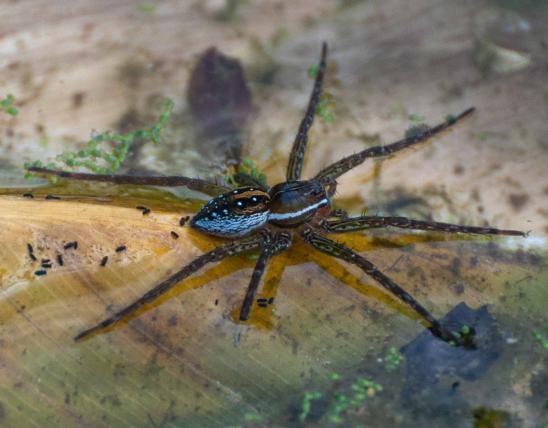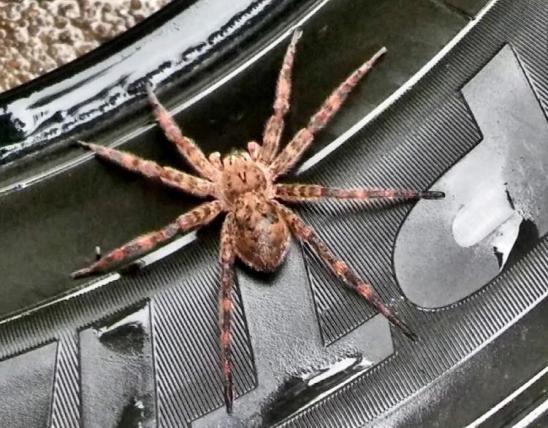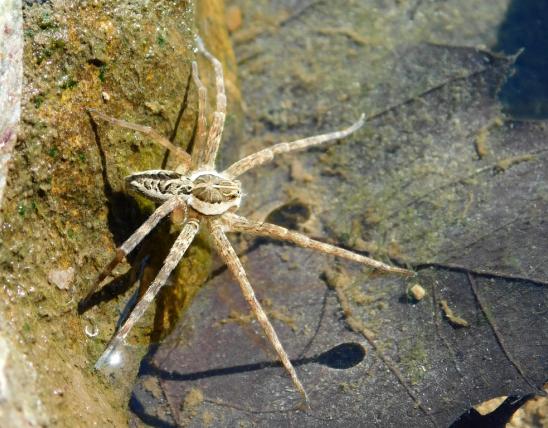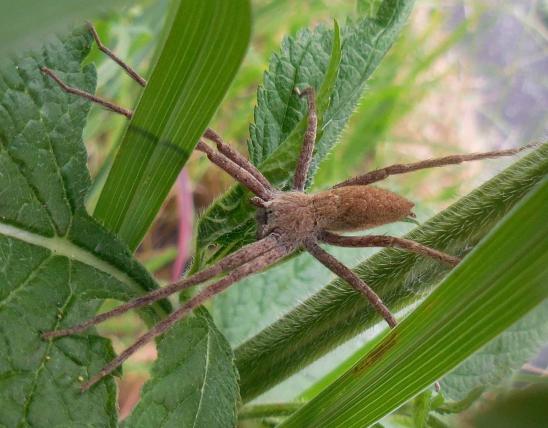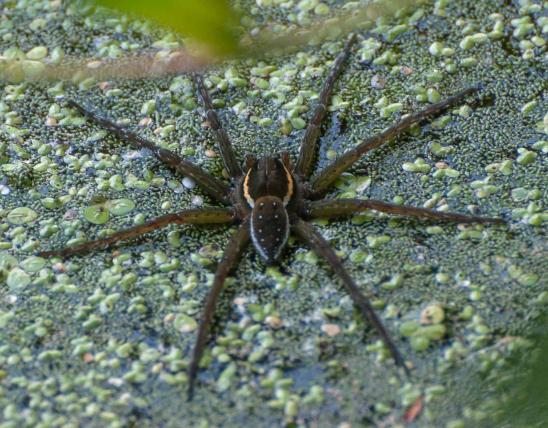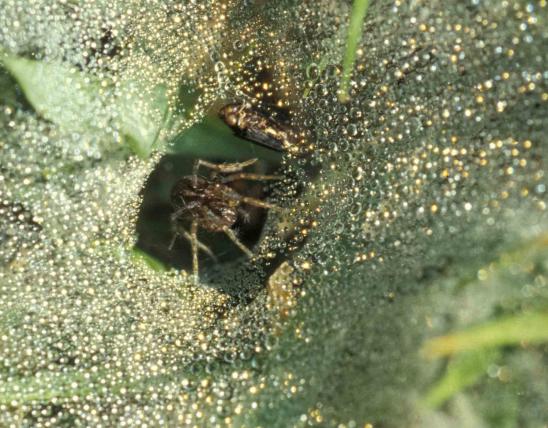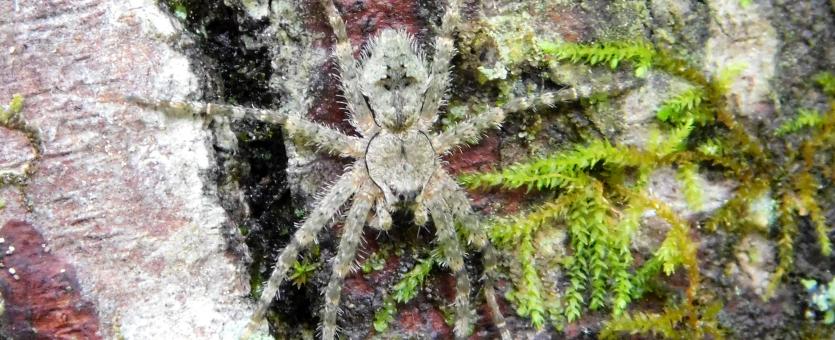
The whitebanded fishing spider is one of eight species in genus Dolomedes in North America north of Mexico. Like the others, it is often associated with aquatic or wet habitats, but unlike most of them, it is also commonly seen away from water, resting on vertical surfaces such as tree trunks or walls. The markings and degree of shading are variable, and the overall hue can be gray, tan, rusty, yellowish, greenish olive, white with black marks, or brown — but there is usually a white band along the front edge of the face (something like a lip above the chelicerae/fangs). Many individuals have a greenish or olive cast to the upper surface of the body, and this is our only fishing spider that can have a green cast. Many individuals may have the carapace (head) white. The stiff hairs on the legs are usually pale and typically stand out at almost right angles to the legs, making them look super-bristly.
Similar species: This and other fishing spiders in genus Dolomedes might be confused with nursery web spiders (Pisaurina spp., which are in the same family), and with various other types of fast-running spiders such as wolf spiders (family Lycosidae) and grass spiders/funnel weavers (family Agelenidae).
Length (not including legs): ⅞ inch (females); ⅝ inch (males).
Statewide.
Habitat and Conservation
This species and the dark fishing spider (Dolomedes tenebrosus) are the two fishing spiders most likely to be found away from water. The whitebanded fishing spider is especially noted for its habit of resting on vertical surfaces such as walls and tree trunks. Look for it in stream bottom habitats and in other fairly moist areas. Fishing spiders do not spin webs, except to create and secure egg cases.
Food
Insects (both aquatic and nonaquatic) and other small prey. Because this species typically ventures pretty far from water, it captures insects as it explores the surfaces of tree trunks, walks across the ground, and so on: flies, moths, beetles, mayflies, and other insects.
Fishing spiders, as a group, are semiaquatic, typically resting and walking on the surface of the water, and able to feel vibrations of insects that have fallen accidentally into the water. Fishing spiders then typically rush across the water’s surface to nab prey. The whitebanded fishing spider, however, reportedly is rarely seen hunting on the water this way.
Life Cycle
As a general rule, spiders in temperate areas hatch from eggs in spring and spend the growing season eating, maturing, mating, and laying eggs. Female spiders are usually much larger than males and sometimes eat the males after mating. Females continue creating egg cases as long as the weather holds out. As temperatures cool in fall, their metabolism slows, and they generally die when it freezes. Egg cases overwinter, and spiderlings hatch in spring.
As with other fishing spiders, females of this species typically carry their egg sacs in their chelicerae (fangs). This is a helpful way to distinguish between fishing spiders and wolf spiders, which typically carry their egg sacs attached to the spinnerets at the hind end of the body. (Wolf spiders that have dropped and retrieved an egg sac may temporarily carry it in their fangs, however.)
Human Connections
Fishing spiders and other lowland and aquatic insect-eaters capture and consume countless flies and other insects that vex us when we’re boating, fishing, or trying to enjoy a streamside picnic. And spiders, like these, that creep on tree trunks no doubt capture many insects that can harm trees. It’s up to us to decide whether or not to be afraid of spiders. We can train ourselves to tolerate them and appreciate the all-natural pest-control services they provide.
Ecosystem Connections
The greenish or olive coloration is almost certainly a form of camouflage, helping this spider blend in with moss- and lichen-covered tree trunks, stream banks, and moist cliff faces. The other colors likewise help these spiders blend in with the bark and soils they live in. Camouflage can help these spiders to hunt more successfully as lie-in-wait predators, and it may also help them to escape being eaten by birds and other spider-eaters.
